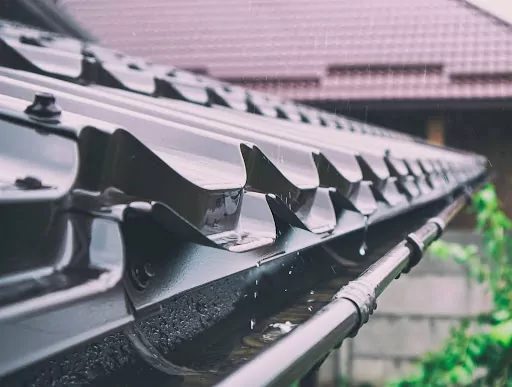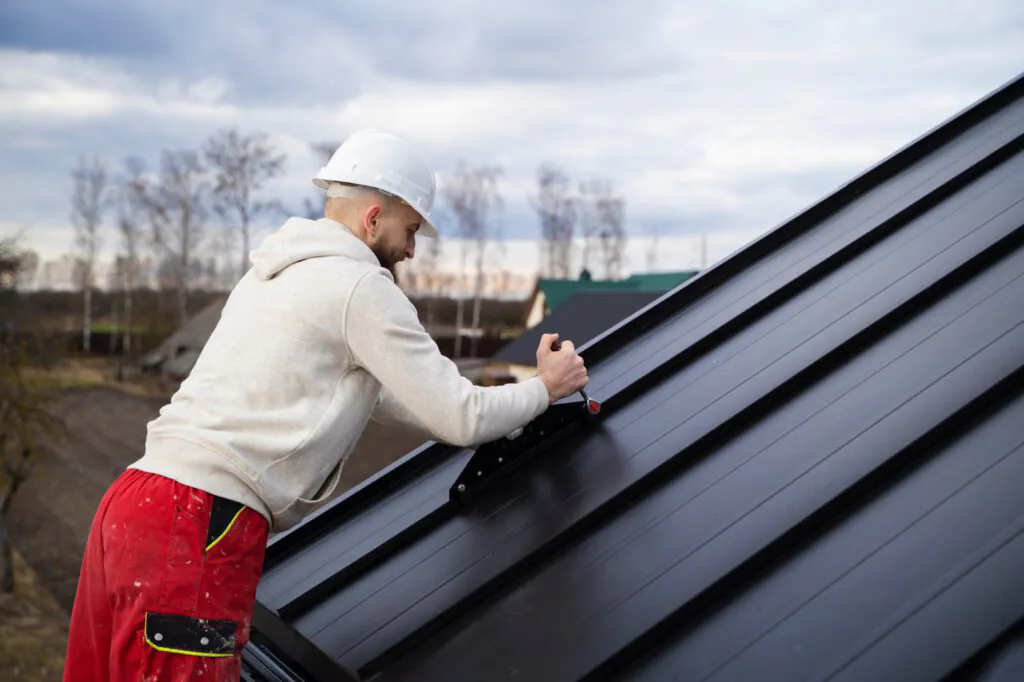Metal roofs for residential properties are a fairly new trend in the United States. A roofing study reported that the demand for metal roofs in the US is expected to rise at an annual average rate of 0.7% per year to 38.07 million squares in 2026. But how does a metal roof work, and what does it mean for you as a homeowner?
As an extremely popular residential roofing option, you may have a number of questions about metal roofs and their ability to serve as the roof over your head. Discover everything you need to know about the pros and cons of metal shingles to help you decide on the best solution. Plus, explore answers to many of the common metal roofing questions we get to help answer all of your concerns.
Types of Metal Roofing for Residential Use
Metal roof tiles are most commonly made of metals like aluminum, copper, steel, and zinc. Metal roofs are most commonly made in the shape and style of either corrugated metal roofs or tile roofs. Corrugated Metal Roofs are made up of sheets of metal shaped into panels and ridges. Because installing corrugated roofs involves fewer, larger pieces, this is a less expensive option than metal tiles, which are placed individually.
In addition to Corrugated Metal Roofs, standing seam metal roofs are another popular style option. This style involves installing vertical panels joined together by interlocking seams, so you may never have to replace your roof again.
- Aluminum: A lighter, softer, and more expensive style of roof compared to steel. An aluminum roof is usually embossed and nearly always painted. Aluminum roofs can last up to around 50 years and are best for climates with salt air or acid rain because it is a metal that doesn’t rust.
- Copper: Roofs made of copper are known to last up to a whopping 200 years. As the longest-lasting, most expensive metal roof option, this metal is easy to cut and shape. Brand-new copper roofs have a beautiful bright, shiny hue. But, when exposed to the elements, copper’s shine quickly turns to a brown patina and then a blue-green shade after many years (just think of a penny or the Statue of Liberty).
- Steel: This metal roof option is the most popular and generally least expensive of metals. To make it stronger, steel roof materials are usually dipped in molten zinc or aluminum-zinc alloys called Galvalume. Steel roofs last 30-50 years and are typically painted to increase lifespan.
- Zinc: Like copper, zinc is a naturally weather-resistant metal and makes an excellent roofing material. It also won’t need paint and weathers into a blueish-gray that can last for 80-100 years.
Benefits of a Metal Shingle Roof
Lifespan: Metal roofs pay for themselves many times over with just their lifespan. They can last about twice as long as traditional asphalt shingle roofs; some manufacturers even offer a lifetime warranty just for metal roofs. A metal roof installation can last up to 50 years. The longevity is due to the material’s ability to withstand the elements. Metal roofs are built to hold up to gusts of wind up to 140 miles per hour and will not rust or fade in the sun.
Style: Metal roofs are most commonly paired with modern, contemporary, and even cottage-style homes – though their popularity has them popping up on all style homes, providing a new, upscale look for the house and the neighborhood. If your roof is the first in the neighborhood to go metal, you’ll be noticed for enhancing your roof style and home value – but you won’t stand out like a sore thumb.
When choosing the look of your metal roof, you have many options – style (panel vs. shingle), color, pattern, etc. – which will determine how brightly it shines in the sea of asphalt.
Lightweight: The lightweight nature of some metal roofs means ease of installation. Homeowners can skip the cost of shingle removal and simply install the metal sheets on top.
Safety: Metal roofs will not catch fire the way other roof-style options may, and some insurance companies will even offer discounted policies if you choose a metal roof for your home.
In addition, metal roofs are immune to rot and insect damage, factors that often shorten the lifespan of other roof styles. Metal roofs typically have a Class A fire rating as they are non-combustible. An impressive safety feature, metal doesn’t spark or catch fire from a lightning strike or wildfire.
Energy Efficient: Metal reflects heat from the sun, which can reduce the cost of cooling your home by 10%-25%! A metal roof is a great way to save money on your energy bill. This reflective property keeps the roof surface much cooler than asphalt shingles, which helps regulate the temperature inside the building. While the metal roof will absorb some of the heat during the day (as does any roof surface), it also quickly releases the heat at night. Federal rebates are sometimes offered for metal roofing that meets EnergyStar requirements. This tax credit is for 10 percent of the cost, up to $500 (not including installation).
Environmentally friendly: Most metal roofs are made of recycled material, and an added bonus is that they can be fully recycled at the end of their life. Also, as mentioned above, its ability to conserve energy makes it an environmentally-friendly roofing option.
Durability: Especially in a state prone to rough weather—severe thunderstorms producing hail and long winters with accumulating snow and ice—it’s important to consider the durability of your roof material.
The Midwest is known for its cold, snowy, icy winters. With snow and ice, ice dams are a common issue, which occurs when a wall of ice builds up on a roof. Metal roofing can prevent ice dams, making it an ideal option for Minnesota homeowners.
Project Efficiency: Undertaking a roofing project can be daunting when you consider time and cost. Another advantage of metal roofing is the ability to install the new roof over the existing shingles. You can certainly choose to start from scratch and tear the old roof off, but it’s not always necessary. CoMitted 365 is here to help you install a new roof atop your existing one and save you money!
Cons of Metal Roofs
Any decision in life comes with pros and cons. Some disadvantages of metal roofs to consider include:
- Price: Metal roofs can be more expensive than other types of roof materials. They are a great investment if you plan on staying in your home for a while, but they may not be worth the investment if you plan on moving soon.
- Noise: Metal can be noisy during heavy rain or storms compared to other roof materials.
- Performance: Metals can rust in certain climates or be more prone to denting or from hail or other damage.
- Expertise: Installation of a metal roof requires professional roofing expertise.
Installing a Metal Roof
If you’re replacing an existing roof, a metal roof can often be installed right on top of what you already have—as long as the current roof weight isn’t an issue with your home’s support or structure. If you are installing a new roof (on a new home), the process is pretty standard. Leaving the old roof in place can decrease labor costs and additional expenses of stripping the old roof off and provide extra insulation for increased energy efficiency.
A layer of underlayment will be laid on top of the decking, and then your metal roof – sheets or shingles – will be installed on top. This provides you with a beautiful roof that meets building code(s) and keeps your home safe and quiet for decades to come.
Metal Shingles Frequently Asked Questions (FAQs)
- How long does a metal roof last? A modest estimate is 30-50 years. 50+ years is standard, which is why most metal roofs come with a 50-year warranty, give or take. Standard asphalt roofs are designed to last 20-30 years (at best), though your climate and weather will have a say in this. When comparing a metal roof vs shingles, asphalt shingles will deteriorate as they are exposed to the sun, wind, rain, heat, cold, and other Minnesota elements, whereas a metal roof will never deteriorate. Any damage or imperfections that happen over time can generally be painted, or small sections can be replaced for repair.
- Are metal shingles more expensive? If you are comparing the initial investment of a metal roof to an asphalt shingle roof (the most common roof option in today’s home construction), then yes. The material and labor required to roof your home with metal will cost double, sometimes triple, that of standard asphalt shingles. However, that is only when comparing the initial investment. It’s important to compare lifetime expenses as well. Asphalt shingles need to be replaced at least every 20-30 years, while metal roofs will, at minimum, double that lifespan. Long term, metal roofs are arguably a more cost-effective solution.
- Are metal roofs louder during storms? They can be; however, if your attic has standard insulation, it should not be an issue. Your home’s insulation works hard to keep you warm and dry but also absorbs outside sounds.
- Will my metal roof attract lightning or heat? No, the likelihood of your home being struck by lightning has less to do with the material of your roof and more to do with the height, size, and proximity to taller objects. Many metal roof materials have a coating that reflects the sun. Compared to asphalt roofs, metal keeps your home cooler and can even save you money on energy bills.
- What should I know about snow and my metal roof? For many Minnesotans, a metal roof’s winter performance might just seal the deal! Unlike other roofing styles, snow and ice just slide off metal roofs, protecting your home from the danger of ice dams and leaks and saving you from the hassle of raking your roof.
- Will a metal shingle roof cost more to insure? Whenever you’re considering making significant changes to your roof and property, call your insurance carrier. The age and material of a roof can affect your insurance coverage and cost – and to most insurance agencies, a metal roof is a good thing. Depending on your situation, a metal roof will likely bring the cost of your insurance policy down!
- Will my phone or wifi service be impacted by a metal roof? Unless your service is spotty or non-existent to start with, your metal roof will not interfere with your ability to call, stream, download, surf, or use your cell phone and wifi in any way you choose.
- Can I still use gutters and/or skylights with a metal roof? Yes, as with all roofs, proper installation techniques must be used to accommodate the metal roof material and its long lifespan. But to answer your question, yes, you can control the light entry and water flow on your roof.
Ask Us for A Metal Roofing Quote
Reach out to CoMitted 365 if you have more questions or if you’d like to get started on a quote for metal roofing on your home today! We offer standing seam metal roofing, a durable and modern roofing solution. Our team of exceptional roofing experts is here to help you make the best decision as a homeowner.





